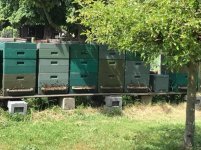T
Teddybrae
Just wundrin Wal ... so AFTER my hive has got a Queen I move it home at night when all the Bees are asleep and they will commence foraging from the new place and return there to feed the Queen?
I have seen on the Web that Native Bees locate VISUALLY and wonder if they will get lost if moved from their old surroundings?
I have seen on the Web that Native Bees locate VISUALLY and wonder if they will get lost if moved from their old surroundings?
hey teddy ,
i asked old mate , he said put your hive near a native hive and rub some of the propolis from the front of the native hive on the opening of your hive ,
that should lure them and they will take care of the rest apparently, hopefully this saves spending so much on getting a queen , eu queen bees are only about $25 usually , a bit of a bargain compared to what you said about the native queens ...
i have a few mangoes , but they are only young and no flowers this season , maybe next one and ill take a good look when they do flower to see whats doing the pollination here ..




